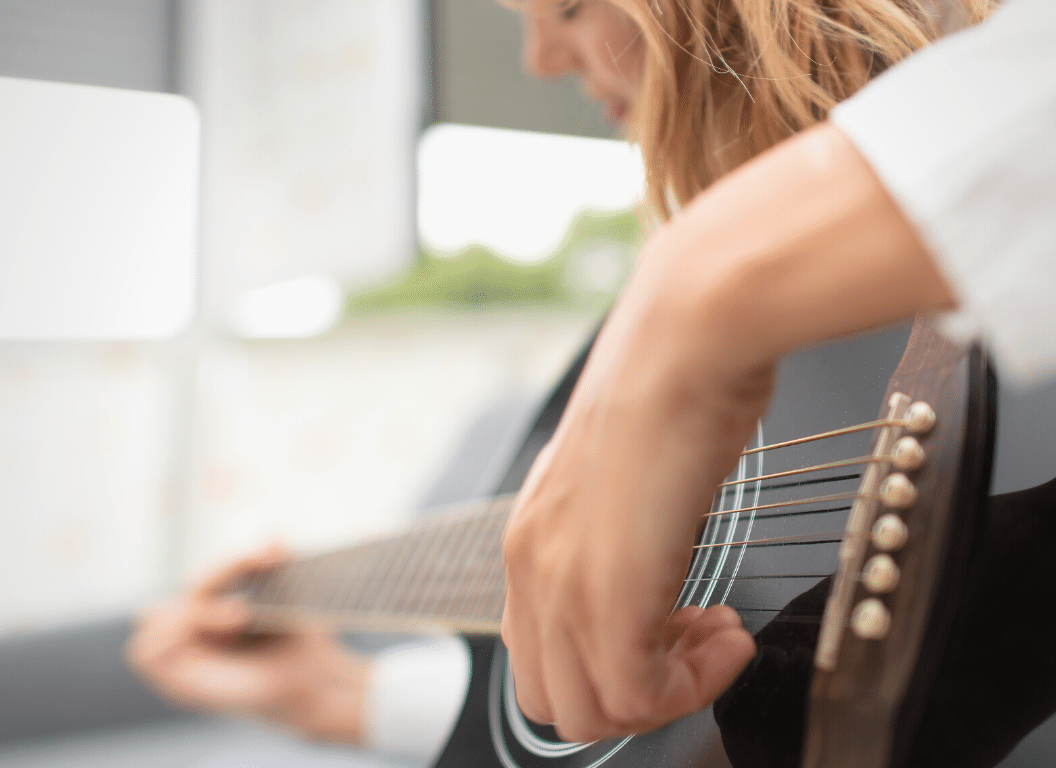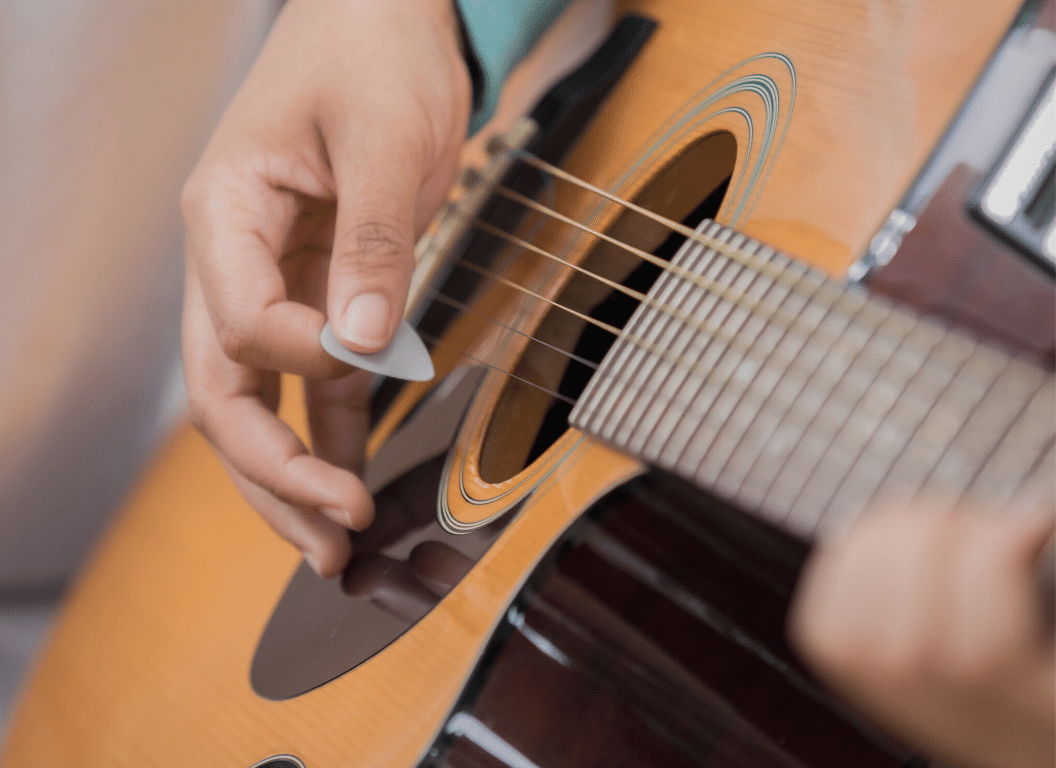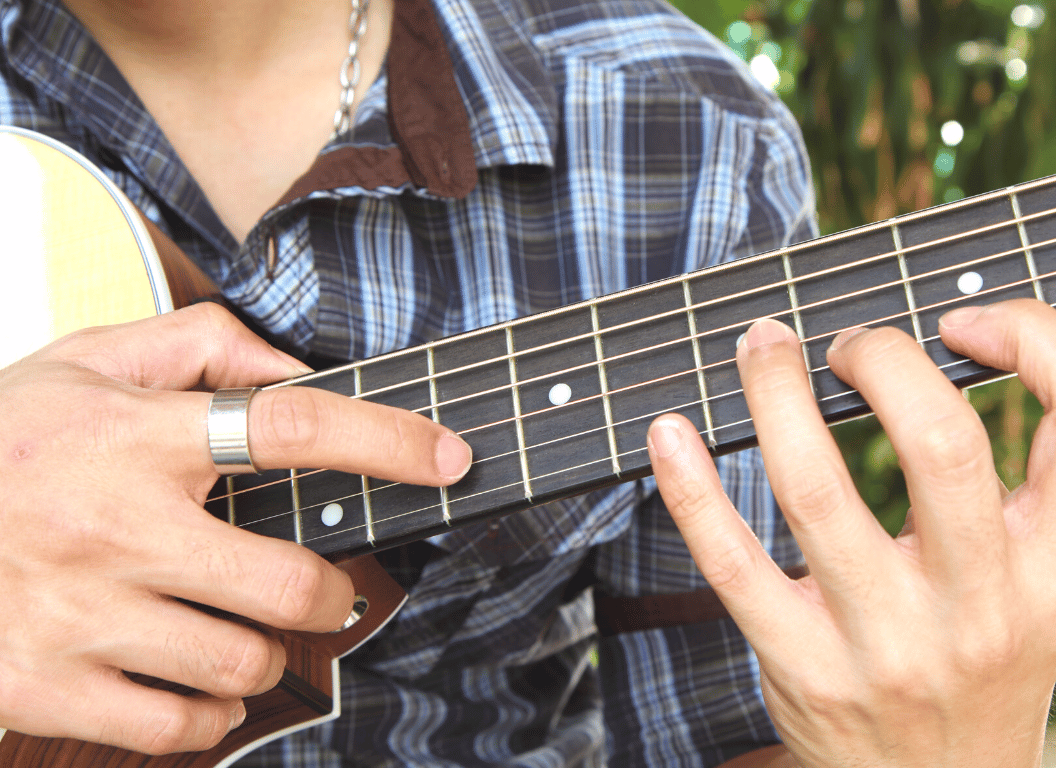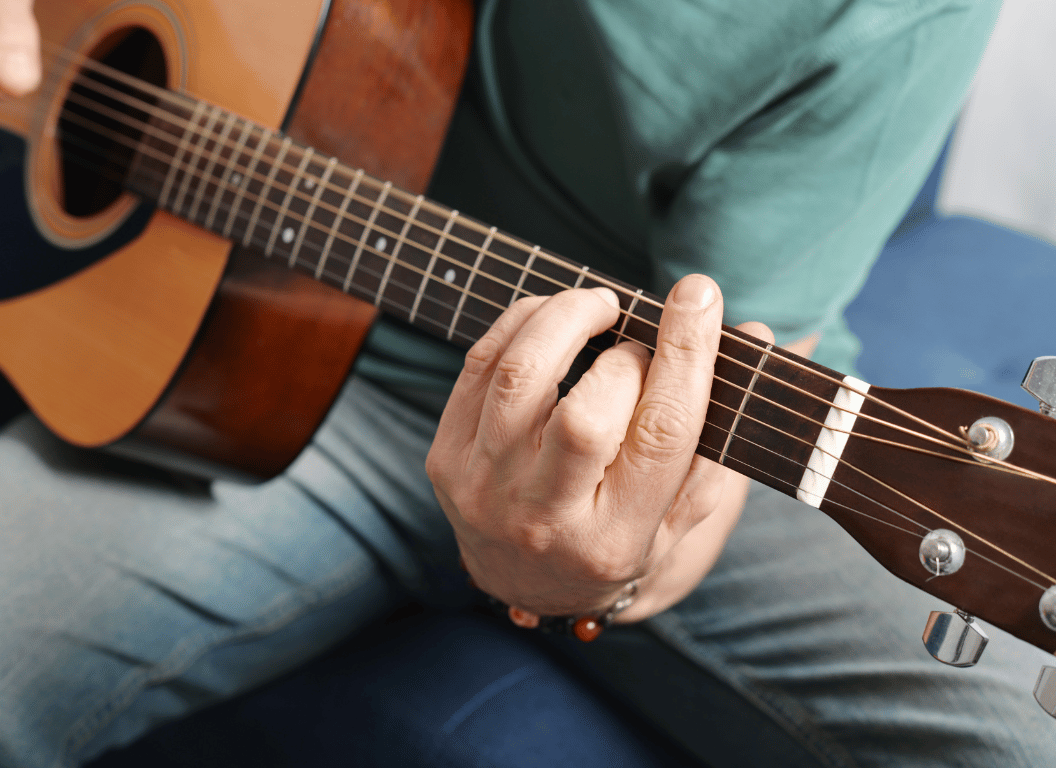Learning to play the guitar is a rewarding journey that requires dedication and practice.
One critical aspect, typically overlooked, particularly among right-handed players, is the proficiency of the left hand.
Optimal utilization of the left hand can significantly improve your overall performance.
Despite its seemingly secondary role, the left hand’s functionality on frets is equally essential as the right hand’s on the strings.
This guide is designed to offer practical advice and beneficial strategies to bolster your left hand technique.
By following these tips, you can unlock your full potential and elevate your guitar playing skills.
Table of Contents
- How To Improve Your Left Hand Technique On The Guitar?
- Learning the Basics: Anatomy of the Left Hand
- Techniques to Improve Coordination in the Left Hand
- Developing Flexibility in the Left Hand for Guitar Playing
- Steps to Enhance the Strength of Your Left Hand
- Exercises for Developing Finger Independence and Agility
- How Does Proper Finger Placement Affect Your Playing?
- Why Should Your Thumb Be Behind the Fretboard?
- Tips on Overcoming Left Hand Fatigue and Cramping
- The Bottom Line
How To Improve Your Left Hand Technique On The Guitar?
Improving your left-hand technique on the guitar requires consistent practice, focusing on coordination, strength, and flexibility. Engage in exercises that develop finger independence and agility such as scales, arpeggios, and chord progressions. Additionally, ensure proper finger placement and keep your thumb behind the fretboard for the most effective leverage.
While the above-mentioned tips provide key starting points for enhancing left-hand technique, it doesn’t stop there.
This article will continue to delve deeper, introducing intricate methods and innovative strategies that will take your guitar skills to the next level.
As we navigate through this insightful piece, we’ll learn not just about physical techniques, but also about the pivotal role of mental discipline and cognition in playing the guitar.
We will elaborate on additional exercises, discuss proper ways to alleviate tension in your hand, and uncover the best practices for effective muscle memory training.
So, stay with us as we unveil valuable information about mastering the strings, fostering the holistic growth of a musician.
Learning the Basics: Anatomy of the Left Hand
In order to fully grasp the importance of the left hand in guitar playing, it’s crucial to first understand the basic anatomy of the hand.
Our hands are composed of a complex network of muscles, tendons, and bones, all working in harmony to perform delicate and robust movements alike.
Primarily, the left hand consists of the wrist, palm, and five fingers, each with three segments separated by joints.
These parts all play an intricate role in our ability to play the guitar effectively and skillfully.
Our hands are composed of a complex network of muscles, tendons, and bones, all working in harmony to perform delicate and robust movements alike.
This is due to the fact that each finger needs to be able to move independently of the others, yet still provide the necessary strength and precision to effectively press down on the guitar strings.
The wrist is also pivotal, offering a range of motion that allows the hand to shift quickly and easily between different positions on the fretboard.
Moreover, learning about the hand’s anatomy can provide valuable insights into how to improve your technique, avoid injuries, and maximize your guitar-playing potential.
Last, the ligaments and tendons can help to enhance flexibility, strength, and endurance in the hand, thus further improving your ability to play the guitar.
Techniques to Improve Coordination in the Left Hand
Any seasoned guitar player would agree that coordination in the left hand is central to quality guitar playing.
It’s the mastery of this coordination that allows you to move from note to note, smoothly playing your music without interference.
A lack of coordination in the left hand can cause you to miss the strings, fumble with the frets, and produce a sound that is far from the melody you intended.
– Begin with Simple Exercises
Starting with simple exercises is often the best route in cultivating left hand coordination.
One such exercise involves only the open strings of your guitar.
Try timing your plucks out so they flow smoothly and maintain this control as you add more strings to your exercises.
Every mistake you make is a step toward your learning curve.
Identifying your mistakes and flaws is just as much a part of the learning process as practicing the correct techniques.
Every mistake you make is a step toward your learning curve.
This statement highlights the importance of noting the mistakes during practice sessions.
They are not to be viewed as failures, but are valuable in your journey of learning to play the guitar efficiently.
Besides, fixing these issues is what propels your progress, significantly boosting hand coordination in the long run.
– Increasing Speed Gradually
You must practice increasing your playing speed gradually as a part of your coordination exercises.
Beginning at a slower pace gives your hand the time it needs to familiarize itself with the movements it’s supposed to make.
As your skills improve, you should be able to increase this to a typical playing tempo.
Remember, increasing the speed doesn’t necessitate missing notes or playing incorrectly.
“Remember, increasing the speed doesn’t necessitate missing notes or playing incorrectly.”
Every guitar player should keep this in mind.
Speed and precision should go hand in hand during practices.
The focus should be on maintaining accuracy in playing while gradually increasing the speed, thus improving overall coordination in the left hand.
As discussed in the video, you can improve coordination by practicing various left hand techniques.
Learn more about the exercises that can help achieve this intermediate level of guitar play.
Developing Flexibility in the Left Hand for Guitar Playing
When it comes to guitar playing, the role of left hand flexibility cannot be overstated.
It is beyond just being able to stretch your fingers across the fretboard, the technique and finesse involved in the finger movement is of utmost importance.
By flexibility, we mean the ability of your fingers to adopt and adjust readily to different chords and notes.
The left hand does most of the hard work on the fretboard and the necessity for it to be agile and flexible is not just for better music, but for the longevity of your guitar playing years as well.
Without having flexibility, you increase the chances of developing cramps, pain and other hand injuries that can severely affect your long-term ability to play the instrument.
By flexibility, we mean the ability of your fingers to adopt and adjust readily to different chords and notes.
This quote emphasizes the ‘why’ behind the need for flexibility while playing guitar.
When you are flexible, you are preventing the occurrence of possible hand injuries related to stiffness and you are also enhancing your chances to play more complex chords and progressions.
The process of developing flexibility in your left hand involves dedicated routine and practice.
Just like how athletes stretch and warm up before engaging in physical exertions, guitarists also need to have a set of warm-up exercises that focus on the left hand.
Starting slow and gradually increasing the pace and complexity of the movements can be a great approach to avoid strain and injury.
Special attention should be given to the pinky finger, as it is typically the weakest of your fingers and often the most ignored one in terms of flexibility training.
Your thumb position also plays a vital role in how flexible your fingers can be.
Special attention should be given to the pinky finger, as it is typically the weakest of your fingers and often the most ignored one in terms of flexibility training.
This quote is important as it emphasizes an often-overlooked aspect in guitar playing.
Many players tend to ignore the pinky finger while practicing and face a wall when they need to hit certain chords or notes later on.
Thus, fingers flexibility is essential for every guitarist.
Also, developing flexibility is not a one-time done and dusted deal.
It is an ongoing process.
Even accomplished guitar players need to keep up with their flexibility exercises to maintain their level of expertise.
The left hand’s role in guitar playing is pivotal and hence, ensuring its flexibility and mobility is a key aspect of becoming a successful guitarist.
Along with practice, it’s also important to maintain a good posture and keep yourself relaxed, as it allows for freer movement in general, aiding to the overall flexibility.
By practising, keeping a good posture, warming up and cooling down after practice, you will, not only improve your flexibility but also prolong your guitar-playing years.
Steps to Enhance the Strength of Your Left Hand
Reaching your full potential as a guitarist relies heavily on the strength of your left hand.
Not infrequently, beginners focus on strumming patterns and neglect left hand strength training.
This is counterproductive as your left hand forms the foundation of your guitar playing ability.
The first thing is to realize is that strength isn’t necessarily a measure of muscle mass.
Rather, it’s about developing the ability to exert the required force to fret chords accurately and hold them for sustained periods.
The stronger your left hand, the better your sound and the more complex chords you can play.
– Overcoming Initial Difficulties
For beginners, it can be challenging to press down on the strings sufficiently to get a clean sound without muting adjacent strings, especially for barre chords.
In this context, building left hand strength will significantly improve your playing ability.
Moreover, endurance will improve, enabling you to play longer without fatigue.
Developing a strong left hand will also help prevent repetitive stress injuries in the future.
Developing a strong left hand will also help prevent repetitive stress injuries in the future.
This is a key point as such injuries, which are fairly common among musicians, can cause long-term discomfort and even endanger your ability to play.
– Left Hand Strength Training Exercises
Deliberate practice is crucial in building left hand strength.
The muscle memory that comes with repetitive actions will enhance both your strength and dexterity.
There’s no shortcut to achieving this.
It requires rigorous practice protocols focusing on challenging chord transitions and advanced playing techniques.
Importantly, the focus should be less on speed and more on building strength and accuracy in your left hand.
Deliberate practice is crucial in building left hand strength.
In tandem with this notion, several exercises and drills can help improve strength and dexterity in your left hand.
These exercises should ideally be incorporated into your practice routine to get the best results.
– Scales and Warm-ups
Regular practice of scales and warm-ups can exert a profound impact on your left hand strength.
The repetitive nature of scales helps improve muscle memory, giving you the ability to play without having to think about every note.
Stretch exercises, such as placing your fingers on different frets and switching positions, can also boost your strength and flexibility.
These exercises can seem tedious but they yield immense benefits as you progress, turning complex chords and fast transitions into second nature.
Regardless of the challenges of playing the guitar, remember to stay patient and consistent, as it is those virtues that truly dull the edges of difficulty.
This video tutorial provides exceptional technique drills for strengthening the left hand.
Not only does it focus on improving strength and endurance, but it also emphasizes proper finger placement and movement.
Exercises for Developing Finger Independence and Agility
When playing the guitar, finger independence and agility often correlate directly with the player’s overall proficiency and the quality of their performance.
Aside from building strength and improving coordination, the exercises that target these aspects likewise serve to boost the fluidity of your movements and reduce the risk of straining and injuring your hand muscles.
– Practicing Chromatic Exercises
One of the most recommended warm-up exercises for guitarists is the chromatic exercise.
This involves playing all twelve pitches within an octave, in a consecutive manner, strictly adhering to the order of ascending and descending.
The chromatic exercise does not only warm up your fingers but also serves as an effective method to practice finger independence and develop synchronicity between your left and right hands.
One of the most recommended warm-up exercises for guitarists is the chromatic exercise.
Continual practice of chromatic exercises can lead to increased finger speed, better coordination, and improved muscle memory.
It’s important to remember, however, to take it slow initially, focusing on precision and proper fingering, and gradually increasing the tempo.
– Practicing String Skipping
A more challenging exercise, string skipping requires you to play notes on non-adjacent strings, leapfrogging over the string in between.
This tends to be troublesome for beginners as it not only demands significant dexterity but also involves a good deal of left-hand precision.
Practicing string skipping exercises can significantly improve the agility of your fingers and enhance your finger positioning skills when playing more complex pieces.
Practicing string skipping exercises can significantly improve the agility of your fingers and enhance your finger positioning skills when playing more complex pieces.
String skipping practice will also lend itself to your hand-eye coordination, as it requires precision and accurate targeting of specific strings.
Like chromatic exercises, start slowly and focus on accuracy before working on speed.
– Employing Legato Exercises
An essential technique in not just classical, but also rock and blues guitar playing, legato involves playing notes smoothly and at a consistent volume, either by using hammer-ons, pull-offs or slides.
Practicing these techniques individually and then incorporating them into a legato sequence is an excellent exercise for developing individual finger strength, independence and agility.
Practicing these techniques individually and then incorporating them into a legato sequence is an excellent exercise for developing individual finger strength, independence and agility.
These exercises require precise maneuvering and a certain level of finger pressure, thus over time, they can also enhance your left hand’s endurance and speed.
Remember to perform these exercises with all degrees of hand motion and to maintain an even tone throughout.
Combining fingertip strength, dexterity and precision, these exercises can significantly improve the mobility and independence of your fingers.
How Does Proper Finger Placement Affect Your Playing?
In approaching the guitar, proper finger placement is critical not only for sounding accurate notes but also for efficient movement across the fretboard.
When playing the guitar, your left-hand fingers typically control which notes ring out.
Improper finger placement can lead to buzzing, muted notes, and more frequent mistakes, detracting from the overall quality of your playing.
Moreover, incorrect positioning may cause discomfort or strain in your hand and fingers, hindering your ability to play for extended periods.
Proper finger placement enables efficient and effortless movement
This is because when your fingers are positioned correctly, they require less movement to hit the desired notes.
Moreover, correct finger placement conserves energy, allowing you to play for longer periods without experiencing fatigue.
The position of your thumb is an important aspect of proper left-hand technique on the guitar.
One common misconception is that your thumb should rest on top of the fretboard, but in fact, the thumb should generally sit behind the fretboard to provide stability and free up your fingers for optimal movement.
This thumb position allows each finger to reach more frets without stretching and lets you move your hand up and down the fretboard more freely.
It might feel a bit awkward initially, especially if you’re accustomed to draping your thumb over the top of the neck, but with time and practice, this position will feel more natural and significantly improve your left-hand technique.
Keeping your thumb behind the fretboard provides stability and flexibility.
It provides a solid foundation for your fingers to press down the strings while also allowing you to achieve wider stretches.
To further understand the importance of proper finger placement, I suggest that you watch the embedded instructional video.
It provides useful tips and strategies to enhance your left-hand positioning on the guitar.
Finger independence is another vital aspect of proper left-hand technique.
Finger independence refers to the ability to move each finger independently of the others, which is essential for playing intricate passages and executing complex chord shapes.
Exercises such as finger stretching and finger isolation drills can enhance your finger independence and improve your playing.
Remember, regular practice is crucial in achieving finger independence.
Achieving this level of control takes time, so patience and consistency are key.
Nurturing finger independence can dramatically improve your playing
With improved finger independence, you’ll not only be able to play more complex chords and riffs, but you’ll also find your overall playing becomes more fluid and efficient.
In summary, correct finger placement is a fundamental aspect of mastering the guitar.
By focusing on proper thumb position and enhancing finger independence, you can dramatically elevate your playing.
Why Should Your Thumb Be Behind the Fretboard?
When it comes to mastering the guitar, understanding how to properly position your left hand is key.
Surely, there’s much more to it than just having a rule for the sake of having a rule – the positioning of your thumb actually has significant effects on your playability and technique.
The thumb plays a pivotal role in your grip while playing acoustic or electric guitar.
Its position directly influences the flexibility, reach, and stability of your left hand.
Having your thumb behind the fretboard allows you to maximize both balance and control over the neck of the guitar.
This enables you to access the frets more easily and without straining your hand or fingers.
The thumb acts as an anchor point, offering support while your fingers move on the frets.
The thumb acts as an anchor point, offering support while your fingers move on the frets.
Given this role, it’s not hard to see its contribution to your technique – it adds flexibility while reducing unnecessary tension, being a foundation upon which your fingers are free to act with precision and agility.
Not only does proper thumb position affect your physical approach to the guitar, but it also significantly impacts the sound quality.
If your thumb is placed correctly, it allows your fingers to press the strings with greater precision and consistency.
This results in better intonation and cleaner sound, as you are able to avoid unwanted string buzzing or muted notes.
The thumb’s position also reduces strain on your wrist which helps maintain good technique over longer playing sessions.
Having your thumb correctly positioned can result in better intonation and cleaner sound.
It emphasizes the importance of thumb positioning and how it directly affects the sound that your guitar produces.
As with any other technique in guitar playing, mastering thumb positioning requires conscientious practice.
Consistently positioning your thumb behind the fretboard at first might be uncomfortable, but with regular practice, it will become more natural and comfortable.
In the end, proper thumb technique helps maximize your ability to play more complex chords and melodies with ease and fluidity.
Without correct thumb positioning, you may also risk developing bad habits which may be harder to fix later on.
Therefore, we recommend practicing on a daily basis, remembering that the goal is not just to play the chords, but to also play them with ease, comfort and a clean sound.
The goal is not just to play the chords, but to also play them with ease, comfort and a clean sound.
By constantly checking your thumb position as you practice, you’ll gradually start to notice improvements in your playing and sound quality over time.
Tips on Overcoming Left Hand Fatigue and Cramping
One of the most common challenges guitarists face relates to left hand fatigue and cramping.
This impediment does not only affect beginners but also happens to experienced players during long performances or practice sessions.
Fortunately, there are several techniques and tips given by experts that you can implement to overcome this issue.
– Proper Hand Positioning
A major contributor to hand fatigue and cramping is improper hand positioning.
Your hand positioning is a fundamental aspect to play the guitar with minimal strain.
Incorrect positioning will exert unnecessary strain on your fingers and wrist, which can lead to fatigue and pain.
Incorrect positioning will exert unnecessary strain on your fingers and wrist, which can lead to fatigue and pain.
This key insight confirms the importance and necessity of maintaining good posture when playing.
Good positioning reduces the pressure and tension on the fingers and wrist, preventing muscle fatigue.
This video provides valuable insights on how effectively to maintain correct hand positioning.
Choosing such subtle nuances can elevate your guitar play abilities and reduce the occurrence of cramps and fatigue.
– Regular Stretching & Resting
Another technique for managing hand fatigue and cramping is regular stretching and rest periods during playing sessions.
Stretching can lead to increased flexibility which in turn decreases the risk of muscle cramps and fatigue.
Besides, taking brief rest periods allows your muscles to recover, eliminate built-up tension and reset.
“Taking brief rest periods allows your muscles to recover, eliminate built-up tension and reset.”
By taking regular rests, you allow your muscles time to recover from activity.
Rest also gives you the chance to shake off any tension that may be building up in your hand during play.
– Proper Hydration & Nutrition
Adequate hydration and balanced nutrition also play a critical role in preventing fatigue and cramping.
Dehydration may lead to muscle cramping, and insufficient intake of minerals like magnesium and potassium is associated with persistent fatigue.
By improving your diet and hydration, you can improve your stamina and playing endurance.
Dehydration may lead to muscle cramping, and insufficient intake of minerals like magnesium and potassium is associated with persistent fatigue.
Being informed about the link between nutrition, hydration, and muscle functionality is beneficial for all guitarists.
By implementing a balanced diet, you can better manage fatigue and cramping, improving your playing experience.
The Bottom Line
Enhancing the ability, strength, coordination, and endurance of your left hand for guitar playing holds significance for numerous reasons.
Understanding the detailed anatomy propels your technical skills, while fostering flexibility and finger independence boosts your ability to execute challenging sequences, thus enriching your performance.
Adopting proper finger and thumb placement can vastly improve the quality of sound.
Moreover, tackling fatigue and cramping issues empowers you to play for longer periods without discomfort.
As emphasized by experts, and proven by countless success stories, optimizing your left hand technique can completely transform your guitar playing journey, pushing you towards virtuosity.

More than 10 years of experience playing and writing about guitars! When not writing, I can be found strumming away some Johnny Cash tunes. Favorite all time guitar is the Gibson Les Paul. #TeamGibson




